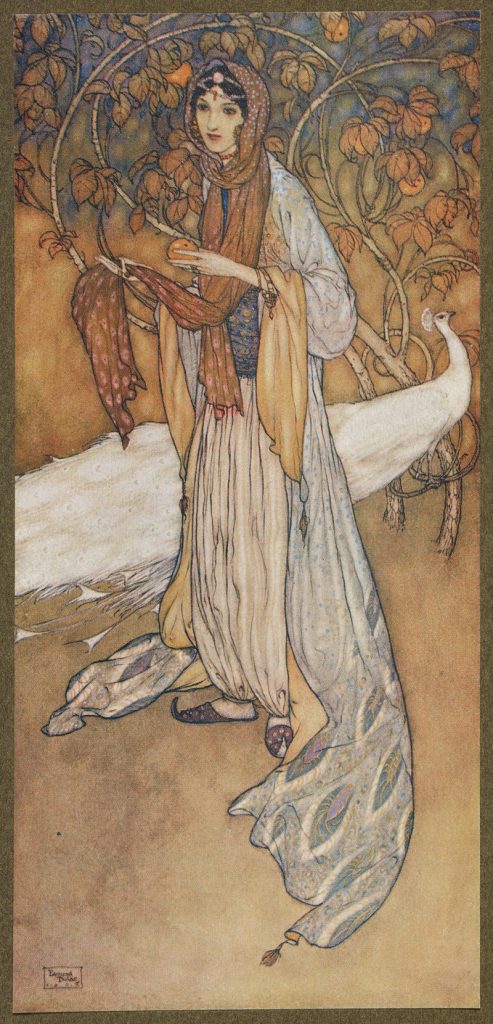Preface

PREFACE
Scheherazadè, the heroine of the Thousand and one Nights, ranks among the great story-tellers of the world much as does Penelope among the weavers. Procrastination was the basis of her art; for though the task she accomplished was splendid and memorable, it is rather in the quantity than the quality of her invention—in the long spun-out performance of what could have been done far more shortly—that she becomes a figure of dramatic interest. The idea which binds the stories together is greater and more romantic than the stories themselves; and though, both in the original and in translation, the diurnal interruption of their flow is more and more taken for granted, we are never quite robbed of the sense that it is Scheherazadè who is speaking—Scheherazadè, loquacious and self-possessed, sitting up in bed at the renewed call of dawn to save her neck for the round of another day. Here is a figure of romance worth a dozen of the prolix stories to which it has been made sponsor; and often we may have followed the fortunes of some shoddy hero and heroine chiefly to determine at what possible point of interest the narrator could have left hanging that frail thread on which for another twenty-four hours her life was to depend.
Yes, the idea is delightful; and, with the fiction of Scheherazadè to colour them, the tales acquire a rank which they would not otherwise deserve; their prolixity is then the crowning point of their art, their sententious truisms have a flavor of ironic wit, their repetitions become humorous, their trivialities a mark of light-hearted courage; even those deeper indiscretions, which Burton has so faithfully recorded, seem then but a wise adaptation of vile means to a noble end. And yet we know that it is not so; for, as a matter of fact, the “Arabian Nights Entertainment” is but a miscellany gathered from various sources, of various dates, and passing down to us, even in its collocated form, under widely differing versions. None but scholars can know how little of the unadulterated originals has come into our possession; and only those whose pious opinions shut their eyes to obvious facts can object in principle to the simplification of a form which, from the point of view of mere story-telling, can so easily be bettered. Even the more accurate of the versions ordinarily available are full of abridgment, alteration, and suppression; and if you have to eliminate Scheherazadè and select your stories mainly with a view to illustration, then you have very largely done away with the reasons for treating tenderly that prolixity which in an impatient age tends to debar readers from an old classic.
And so, in the present version, whoever shall care to make comparison will find that the original material has been treated with considerable freedom in the direction of brevity, and with an almost uniform departure from the exact text, save where essentials of plot or character or local colour required a closer, accuracy. In the case also of conflicting versions, there has been no reluctance to choose and combine in order to secure a livelier result; and a further freedom has sometimes been taken of giving to an incident more meaning and connexion than has been allowed to it in the original. That is, perhaps, the greatest license of all, but it is the one that does least harm in formal result; for no one can read the majority of the tales in their accepted versions without perceiving that, as regards construction and the piecing of event with event, they are either incredibly careless or discreditably perfunctory. We have to reckon with them as the product of a race keenly alive to the value of colour and pictorial description, but a race whose constructive imagination was feeble and diffuse, lacking almost entirely that great essential for the development of art in its finer forms—the economy of means toward ends.
But because they contain, though at a low pressure, the expression of so much life, habit and custom, so many coloured and secluded interiors, so quaint a commingling of crowds, so brilliant and moving a pageantry of Eastern mediævalism, because of all these things the “Arabian Nights” will still retain their perennial charm. Those of us who read are all travelers; and never is our traveling sense so awakened perhaps, as when we dip into a book such as this where the incredible and the common-place are so curiously blended, and where Jinn and Efreet and Magician have far less interest for us now than the silly staring crowds, and the bobbing camels in the narrow streets, and Scheherazadè spinning her poor thin yarn of wonders that she may share for another night the pillow of a homicidal maniac.

